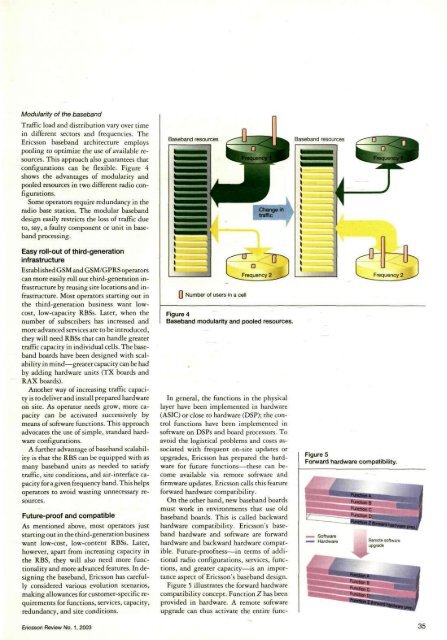ericssonhistory.com
ericssonhistory.com
ericssonhistory.com
- No tags were found...
You also want an ePaper? Increase the reach of your titles
YUMPU automatically turns print PDFs into web optimized ePapers that Google loves.
Modularity of the basebandTraffic load and distribution vary over timein different sectors and frequencies. TheEricsson baseband architecture employspooling w optimize the use of available resources.This approach also guarantees thatconfigurations can be flexible. Figute 4shows the advantages of modularity andpooled resources in two different radio configurations.Some operators require redundancy in theradio base station. The modular basebanddesign easily restricts the loss of traffic dueto, say, a faulty <strong>com</strong>ponent or unit in basebandprocessing.Easy roll-out of third-generationinfrastructureEstablished GSM and GSM/GPRS operatorscan more easily roll out third-generation infrastructureby reusing site locations and infrastructure.Most operators starting out inthe third-generation business want lowcost,low-capacity RBSs. Later, when thenumber of subscribers has increased andmore advanced services are to be introduced,they will need RBSs that can handle greatertraffic capacity in individual cells. The basebandboards have been designed with scalabilityin mind—greater capacity can be hadby adding hardware units (TX boards andRAX boards).Another way of increasing traffic capacityis to deliver and install prepared hardwareon site. As operatot needs grow, more capacitycan be activated successively bymeans of software functions. This approachadvocates the use of simple, standard hardwareconfigurations.A further advantage of baseband scalabilityis that the RBS can be equipped with asmany baseband units as needed to satisfytraffic, site conditions, and air-interface capacityfor a given frequency band. This helpsoperators to avoid wasting unnecessary resources.Future-proof and <strong>com</strong>patibleAs mentioned above, most operators juststarting out in the thitd-generation businesswant low-cost, low-content RBSs. Later,however, apart from increasing capacity inthe RBS, they will also need more functionalityand more advanced features. In designingthe baseband, Ericsson has carefullyconsidered various evolution scenarios,making allowances for customer-specific requirementsfor functions, services, capacity,redundancy, and site conditions.Figure 4Baseband modularity and pooled resources.In general, the functions in the physicallayer have been implemented in hardware(ASIC) or close to hardware (DSP); the controlfunctions have been implemented insoftware on DSPs and board processors. Toavoid the logistical problems and costs associatedwith frequent on-site updates orupgrades, Ericsson has prepared the hardwarefor future functions—these can be<strong>com</strong>eavailable via remote software andfirmware updates. Ericsson calls this featureforward hardware <strong>com</strong>patibility.On the other hand, new baseband boardsmust work in environments that use oldbaseband boards. This is called backwardhardware <strong>com</strong>patibility. Ericsson's basebandhardware and software are forwardhardware and backward hardware <strong>com</strong>patible.Future-proofness—in terms of additionalradio configurations, services, functions,and greater capacity—is an importanceaspect of Eticsson's baseband design.Figure 5 illustrates the forward hardware<strong>com</strong>patibility concept. Function Z has beenprovided in hardware. A remote softwateupgrade can thus activate the entire func-Figure 5Forward hardware <strong>com</strong>patibility.Ericsson Review No. 1, 2003 35















